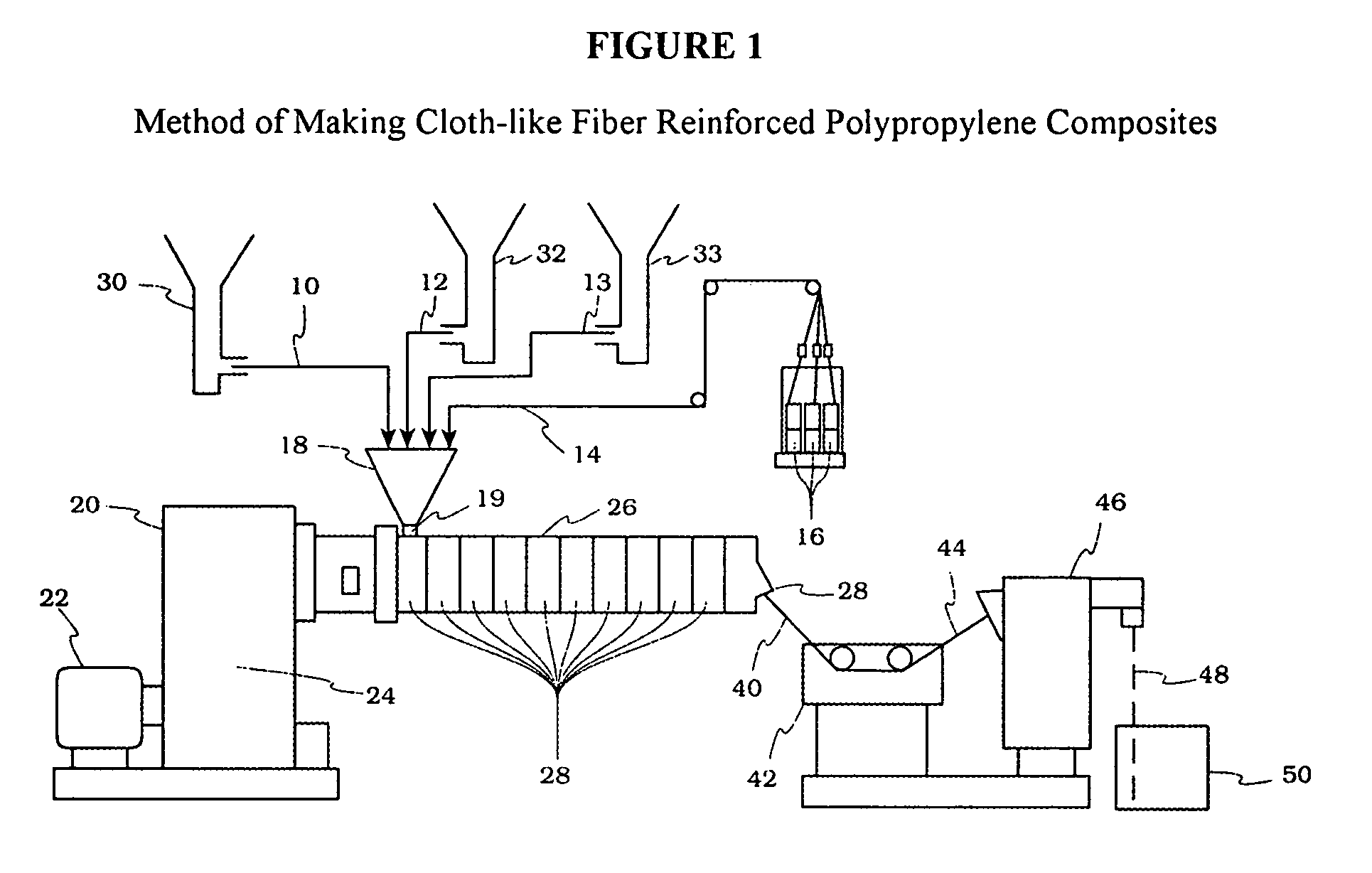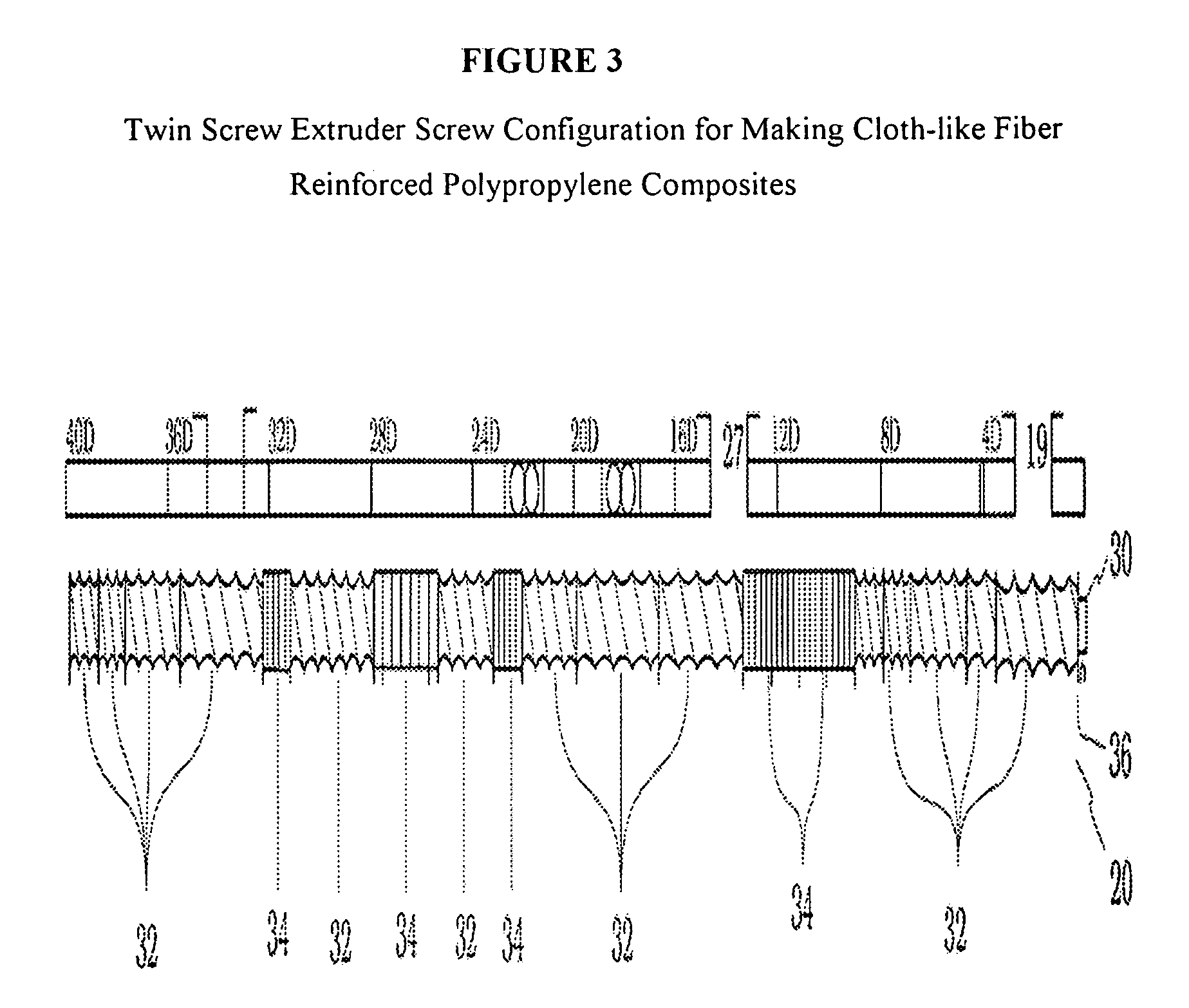Cloth-like fiber reinforced polypropylene compositions and method of making thereof
a technology of polypropylene composition and cloth, which is applied in the field of cloth-like fiber reinforced polypropylene composition and the method of making thereof, can solve the problems of low stiffness, limited use of polyethylene in engineering applications, and low stiffness of polyethylene, and achieve the effect of not reducing the impact properties
- Summary
- Abstract
- Description
- Claims
- Application Information
AI Technical Summary
Benefits of technology
Problems solved by technology
Method used
Image
Examples
examples
[0086] PP3505G is a propylene homopolymer commercially available from ExxonMobil Chemical Company of Baytown, Tex. The MFR (2.16 kg, 230° C.) of PP3505G was measured according to ASTM D1238 to be 400 g / 10 min.
[0087] PP7805 is an 80 MFR propylene impact copolymer commercially available from ExxonMobil Chemical Company of Baytown, Tex.
[0088] PP8114 is a 22 MFR propylene impact copolymer containing ethylene-propylene rubber and a plastomer, and is commercially available from ExxonMobil Chemical Company of Baytown, Tex.
[0089] PP8224 is a 25 MFR propylene impact copolymer containing ethylene-propylene rubber and a plastomer, and is commercially available from ExxonMobil Chemical Company of Baytown, Tex.
[0090] PO1020 is 430 MFR maleic anhydride functionalized polypropylene homopolymer containing 0.5-1.0 weight percent maleic anhydride.
[0091] Cimpact CB7 is a surface modified talc and V3837 is a high aspect ratio talc, both available from Luzenac America Inc. of Englewood, Colo.
[0092...
example 30
Illustrative Example 30
[0110] An extruder with the same size and screw design as examples 27-29 was used. All zones of the extruder were initially heated to 180° C. PP 3505 dry mixed with Jetfine 700 C and PO 1020 was then fed at 50 pounds per hour using a gravimetric feeder into the extruder hopper located approximately two diameters from the beginning of the extruder screws. Polyester reinforcing fiber with a denier of 7.1 and a thickness of 3100 filaments was fed through the same hopper. The screw speed of the extruder was then set to 596 revolutions per minute, resulting in a feed rate of 12.1 pounds of fiber per hour. After a uniform extrudate was attained, all temperature zones were lowered to 120° C., and the extrudate was pelletized after steady state temperatures were reached. The final composition of the blend was 48% PP 3505, 29.1% Jetfine 700 C, 8.6% PO 1020 and 14.3% polyester reinforcing fiber.
[0111] The PP composite resin produced while all temperature zones of the e...
PUM
| Property | Measurement | Unit |
|---|---|---|
| flexural modulus | aaaaa | aaaaa |
| flexural modulus | aaaaa | aaaaa |
| size | aaaaa | aaaaa |
Abstract
Description
Claims
Application Information
 Login to View More
Login to View More - R&D
- Intellectual Property
- Life Sciences
- Materials
- Tech Scout
- Unparalleled Data Quality
- Higher Quality Content
- 60% Fewer Hallucinations
Browse by: Latest US Patents, China's latest patents, Technical Efficacy Thesaurus, Application Domain, Technology Topic, Popular Technical Reports.
© 2025 PatSnap. All rights reserved.Legal|Privacy policy|Modern Slavery Act Transparency Statement|Sitemap|About US| Contact US: help@patsnap.com



